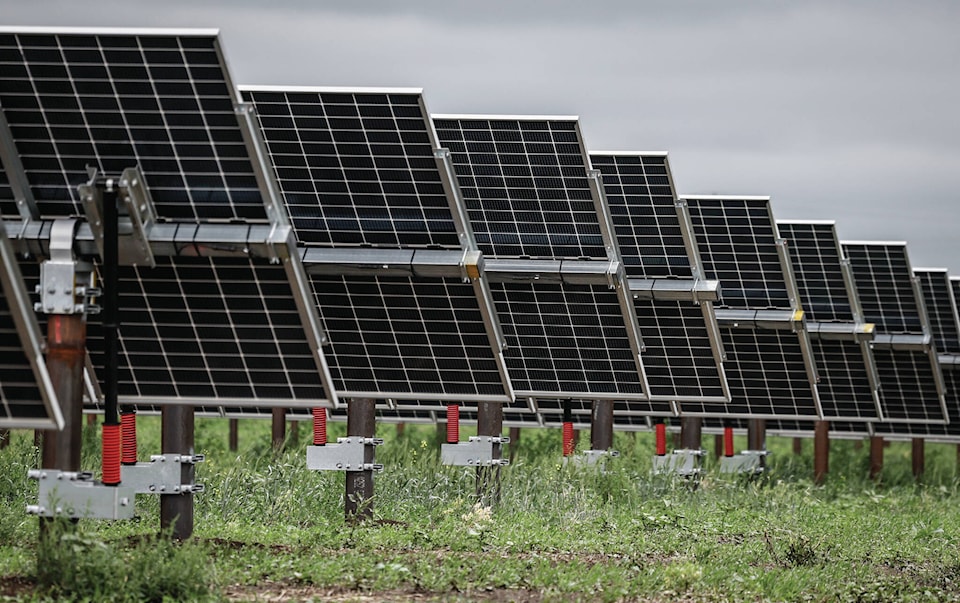The Calgary-based energy company proposing a 170-megawatt solar project near Sylvan Lake welcomes the province’s new rules for future wind and solar projects.
On Wednesday, Alberta Premier Danielle Smith and Affordability and Utilities Minister Nathan Neudorf announced sweeping new regulations for renewable energy projects, especially for wind turbines, which will see the areas they are allowed significantly reduced.
It was also announced the Alberta Utilities Commission (AUC) will follow an “agriculture first” approach when evaluating proposed renewables projects on agricultural lands. The province will no longer permit renewable generation developments on Class 1 and Class 2 farmland — which include some of the best growing soil — unless crops or livestock can coexist with the proposed renewable generation project.
Kiwetinohk Energy Corp. plans to build its solar project on about 955 private acres of private land, a few kilometres southwest of Sylvan Lake. The $320-million solar facility will be linked to the province’s electrical grid by a 188-kilovolt transmission line.
“We welcome the government’s new requirements for all solar projects in the province,” said Craig Parsons, vice-president of finance and economics for Kiwetinohk’s Green Energy Division.
“The policy direction put forward incorporates best practices around agrivoltaics and reclamation security that we have already adopted after speaking with numerous landowners in and around all our projects, as well as Phoenix Solar (the Sylvan Lake project),” Parsons said.
“It holds the industry to a consistently high standard and creates a level playing field and provides clarity and allows responsible solar developments to move forward.”
Parsons said the Sylvan Lake project would be built on Class 3 land, which means the regulations requiring livestock and agriculture to coexist would not apply. However, the company had already planned to take that approach, which could see livestock grazing between solar panels, at the Sylvan Lake project and other locations.
“We believe it’s the right approach,” said Parsons.
The premier announced a 35-kilometre buffer zone will be established around protected areas and other “pristine viewscapes.”
While primarily aimed at wind turbines, other developments could be required to undertake a visual impact assessment depending on the circumstances.
Parsons said they are still waiting to see what the final regulations around buffer zones entail and whether the Sylvan Lake project would fall within a buffer zone.
“I do know we have done some renderings of the project viewscape for several landowners anyway and received support for the project based on those and the design of the project, which uses some landscaping features to reduce visibility.
“We are working very hard to address landowner concerns regardless of the regulations and view responsible development as an absolute requirement for our company.”
The province says developers will be responsible for reclamation costs, provided directly to the Alberta government or negotiated with landowners if sufficient evidence is provided to the AUC.
Kiwetinohk has said it will ensure it has the funds to clean up when the solar facility is no longer used. The company will have an independent engineer review reclamation costs every five years and a fund will be created to ensure there is enough money to cover the cost of cleaning up and restoring the land fully to its former use.
Alberta Utilities Commission announced on Feb. 15 that Kiwetinohk had made an application for its solar project and a substation. Those who feel they will be affected by the project have until March 15 to make written submissions to the AUC.
The town of Innisfail was also caught up in the pause on renewable energy project approvals for projects greater than one megawatt.
A planned solar power generation facility on six acres in a local industrial park would produce up to two megawatts of electricity but has remained in limbo.
It is unclear where that stands now
“Our administrative staff hasn’t had an opportunity to review the province’s material yet,” said town spokesperson Ken Kowalchuk. “We also haven’t received a response to our application, so at this point, we don’t know how today’s announcements will affect our project.”
